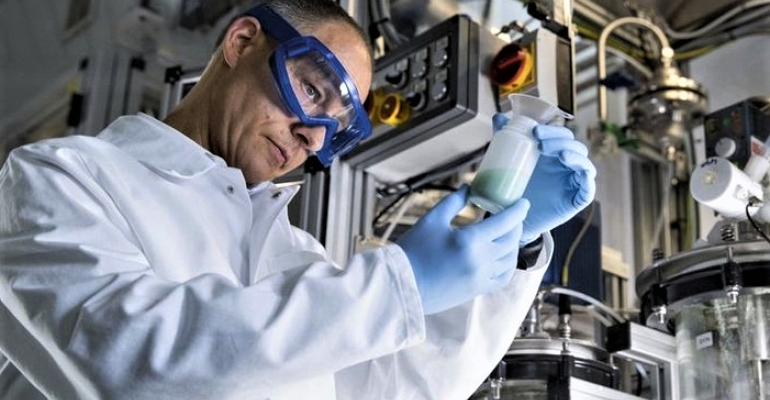When e-mobility is discussed within the automotive industry and by politicians, the discussion tends to center around battery cells and cathode active materials. Of course, that is the “fuel” of e-mobility, but there is much more to address to make this transformation in the automotive industry happen – such as materials, coatings and coolants – that are just as much of a driving force behind e-mobility.
It All Starts With Safety
Flame initiation and flame propagation at cathode metals caused by high voltage or switching arcs require materials equipped with flame retardancy (FR) agents for connectors, cable jacketing or AC/DC converter housings at a level not required for combustion engines. And many more parts require FR agents.
Because the powertrain is electrified, thermal expansion in busbars between the metal conductor and plastic leads needs to be addressed by development, as well as cushioning the sound of the electric engine into the interior. The noise, vibration and harshness performance of engine and frame mounts needs to be redesigned.
Plus, due to the added weight of the battery components on board, crash absorbers require new geometries and sophisticated materials such as particle foams that are light and absorb and distribute crash energy.
Further, special coating materials for the battery box are necessary to inhibit flame initiation, as well as protect the steel box against corrosion triggered by the electrolyte. The battery box is coated with a specific e-coat technology with high throwing power at low film builds. Due to its formulation, it is eco-friendly as it requires a lower baking temperature.
The optimum temperature range to charge and discharge the battery is between 95° and 104° F (35° and 40° C). Special coolants need to be developed with a minimum of ion content and traces of water to manage the temperature and featuring electromagnetic shielding, i.e., electromagnetic waves must not be transmitted outside the battery box.
Of course, this also applies to the necessary infrastructure of e-mobility – high-voltage cables, power switches, power electronics, plugs, coolants, etc. Compliant materials to UL94 ratings, high CTI, RTI, IPT or glow wire resistance are mandatory.
The emerging segment of e-mobility is a huge opportunity for innovation on more chemistries than just the battery, which is making this transformation so fascinating. Yet transformation is a big word and implies different aspects which must be considered.
First Aspect: Innovations for Mobility Need Holistic Approaches
Creating automotive solutions requires a holistic view of OEM requirements for new materials, especially when it comes to the interaction of components of the electric powertrain and surrounding materials.
For example, PU Thermal Conductive Adhesion does not adhere well to a metal or to a PE film with which the battery cell is wrapped for insulation reasons. In such cases, companies must leverage the right connections between expert teams in their own company and specialists within their suppliers. A broad portfolio of automotive solutions and experience enables manufacturers to provide customers with a 360-degree, all-encompassing approach.
Second Aspect: Transformation Can Only Succeed If Industry Works Together
Think outside the box and beyond the boundaries of your own company. Today, companies must be committed to driving collaboration toward an efficient and sustainable automotive value chain.
An example of this is the automotive alliance, Catena-X. It sees itself as an extensible ecosystem in which automotive manufacturers and suppliers, dealer associations and equipment suppliers, including the providers of applications, platforms and infrastructure, can participate equally. The purpose of Catena-X is to create a uniform standard for information and data sharing throughout the entire automotive value chain to improve quality, efficiency, processes, sustainability and more.
Third Aspect: People and Co-Creation Make the Difference
The transformation the automotive industry is currently undergoing is by no means abstract. It affects the individual experts, who also must acquire new knowledge.
 Take a plastics engineer at an OEM who used to design materials for combustion engines. He or she may now find themselves in the department for battery components, tackling massive safety aspects. This is where the contribution of a partner supplier excels beyond research and formulation to provide application and customer-specific support.
Take a plastics engineer at an OEM who used to design materials for combustion engines. He or she may now find themselves in the department for battery components, tackling massive safety aspects. This is where the contribution of a partner supplier excels beyond research and formulation to provide application and customer-specific support.
Automakers place great value on the know-how suppliers have acquired with materials over the past decades and their ability to develop new solutions by collaborating.
These few examples provide only a glimpse at what is comprised in the broad term “transformation of mobility.” Of course, this also encompasses new business models, political support, new urban concepts and much more. It will be crucial to embrace this complexity and integrate it into daily work, no matter what role you play in the automotive industry.
Josef Wuensch (pictured, above left) is a senior vice president at BASF and leads the R&D activities for biopolymers, polycondensation and additive manufacturing technologies as well as polymer processing technologies.





